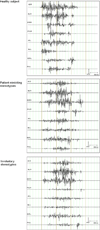Absent movement-related cortical potentials in children with primary motor stereotypies
- PMID: 24259275
- PMCID: PMC4028443
- DOI: 10.1002/mds.25753
Absent movement-related cortical potentials in children with primary motor stereotypies
Abstract
The underlying pathophysiologic mechanism for complex motor stereotypies in children is unknown, with hypotheses ranging from an arousal to a motor control disorder. Movement-related cortical potentials (MRCPs), representing the activation of cerebral areas involved in the generation of movements, precede and accompany self-initiated voluntary movements. The goal of this study was to compare cerebral activity associated with stereotypies to that seen with voluntary movements in children with primary complex motor stereotypies. Electroencephalographic (EEG) activity synchronized with video recording was recorded in 10 children diagnosed with primary motor stereotypies and 7 controls. EEG activity related to stereotypies and self-paced arm movements were analyzed for presence or absence of early or late MRCP, a steep negativity beginning about 1 second before the onset of a voluntary movement. Early MRCPs preceded self-paced arm movements in 8 of 10 children with motor stereotypies and in 6 of 7 controls. Observed MRCPs did not differ between groups. No MRCP was identified before the appearance of a complex motor stereotypy. Unlike voluntary movements, stereotypies are not preceded by MRCPs. This indicates that premotor areas are likely not involved in the preparation of these complex movements and suggests that stereotypies are initiated by mechanisms different from voluntary movements. Further studies are required to determine the site of the motor control abnormality within cortico-striatal-thalamo-cortical pathways and to identify whether similar findings would be found in children with secondary stereotypies.
Keywords: EEG; motor control; motor stereotypies; movement-related cortical potentials.
© 2013 International Parkinson and Movement Disorder Society.
Conflict of interest statement
Figures



References
-
- Wolf DS, Singer HS. Pediatric movement disorders: an update. Curr Opin Neurol. 2008 Aug;21(4):491–496. - PubMed
-
- Singer HS. Motor stereotypies. Semin Pediatr Neurol. 2009 Jun;16(2):77–81. - PubMed
-
- Harris KM, Mahone EM, Singer HS. Nonautistic motor stereotypies: clinical features and longitudinal follow-up. Pediatr Neurol. 2008 Apr;38(4):267–272. - PubMed
-
- Mahone EM, Bridges D, Prahme C, Singer HS. Repetitive arm and hand movements (complex motor stereotypies) in children. J Pediatr. 2004 Sep;145(3):391–395. - PubMed
Publication types
MeSH terms
Grants and funding
LinkOut - more resources
Full Text Sources
Other Literature Sources

